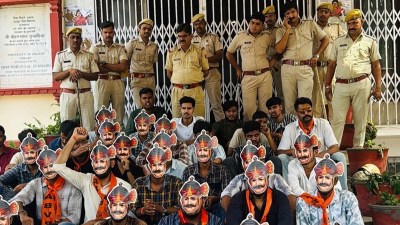Taking note of the heavy traffic in Shimla, police have reintroduced the ‘One Minute Traffic Plan’ in the city to make the state capital jam-free and reduce the commute time.
The decision to implement the ‘One Minute Traffic Plan’ was taken after assessing the number of vehicles – 4.89 lakh – especially from other states, that has entered the state capital in the last 11 days since June 1, the day when summer vacations start in most states. The vehicular population of Shimla itself is over 80,000, including two-wheelers and four-wheelers.

According to the plan, at points 6-8 km from entering Shimla city, every minute motor vehicles will be released for 20 to 30 seconds and stopped for 40 to 30 seconds.
“The plan is very simple. It is based on time, number, and space. In the last two months, a trial on all bottlenecks was carried out along with studying the capacity of inflow and outflow of vehicles. Based on the study, the effectiveness of measures to decongest roads was tested. Halting points have a limited capacity to hold up vehicular traffic. Surplus vehicles are held up at 1-Minute holding points as a need-based arrangement. At each point, vehicles are released every minute in the ratio of 40/20 or 30/30, meaning every minute, vehicles will be stopped for 40 seconds and released for 20 seconds. No constant holding-up of vehicles lasts more than 1 minute. This takes a maximum of 10 minutes in the line segment of 500 metres, which will be the maximum line at each halting point,” SP (Shimla) Sanjeev Gandhi told The Indian Express.
Sources said, “In the first two weeks of June, over 4 lakh vehicles entered and exited Shimla from all directions. This is a significant number for a hill city like Shimla. In previous years, Shimla faced acute traffic jams. Police introduced the ‘One Minute Traffic Plan’ to decongest Shimla which is an absolutely need-based arrangement devised by the district police. This plan proved successful in the last summer and winter seasons and significantly reduced congestion. The main objectives of this plan are to reduce traffic congestion at bottlenecks, which used to turn into long-duration jams consuming 70 to 90 minutes during peak hours. The duration used to be more during the peak tourist season, affecting tourism business. Tuesday was the first day of reimplementing this plan in Shimla this year.”
There are five entry points to Shimla: Old Barrier, Panthaghati, Tavi Mod, Mashobra, and Chharabra. Between June 1 and June 11, a total of 4.89 lakh vehicles crossed (in and out) from these five points. As many as 1.39 lakh vehicles crossed Chharabra, followed by 1.12 lakh at Old Barrier, 98,000 at Tavi Mod, 87,889 at Panthaghati, and 51,402 vehicles at Mashobra. At present, there are over 80,000 registered vehicles, including two-wheelers and four-wheelers, in Shimla city. The major residential areas in Shimla are the Core City, part of Kaithu, Shankli, Longwood, Chhota Shimla, Jakhoo, Kasumpti, Sanjauli, Summer Hill, Boileauganj, and Tutikandi.
Traffic chaos is routine within Shimla. The main stretches affected by traffic jams include Old Barrier to Tunnel 103, Tunnel 103 to Victory Tunnel, Victory Tunnel to Old ISBT-Shimla, Chhota Shimla to Kasumpti, and Chhota Shimla to Sanjauli, especially during the morning and evening hours. On a normal working day, three bus terminals witness about 49,633 boarding and alighting passengers. A total of 264 buses, including government and private buses under government permits, run in the Shimla Planning Area.
Story continues below this ad
Police said the plan aims to make the city jam-free, give uninterrupted access to hospitals and emergency services, decrease the time of commuting, prioritise commute time of school children in the morning and afternoon and ease workers’ rush during 9-11 am and 5-7 pm.
Last year Shimla police had introduced the ‘One Minute Traffic Light Plan’ and implemented it for at least one-and-a-half months.
Portable traffic lights
Shimla police has also decided to introduce portable traffic lights in the town in view of the increasing traffic. The traffic jams keep changing from one place to another in Shimla. “Keeping this in mind, we have decided to procure portable traffic lights which will be moved from one place to another on the basis of traffic rush in different locations,” a traffic police officer said.
How ‘One Minute Traffic Light Plan’ works?
Under the ‘One Minute Traffic Light Plan’, based on time, number, and space, traffic would be released every minute in the ratio of 40:20 or 30:30 seconds – which means vehicles would be halted for 40 seconds and released for 20 seconds every minute during rush, and released and halted for 30 seconds during normal times. The halting distance will no more than 500 metres at any point.









